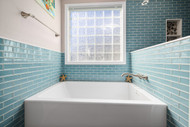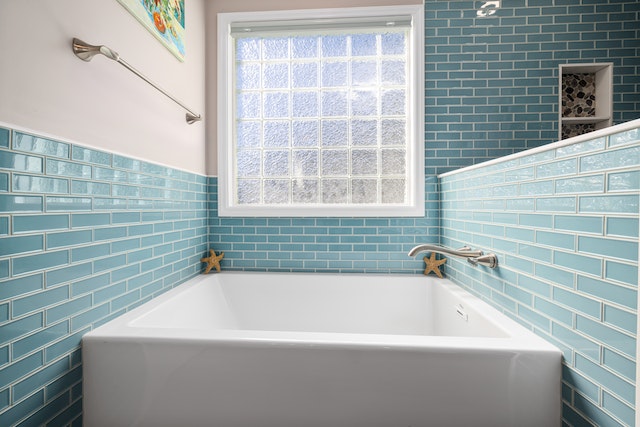Bathroom Wall Tile Height: How High Should You Go?
Posted by Mike Belk on Mar 23, 2023

The bathroom is a vital part of any home, and the tiles used on its walls significantly affect its aesthetic appeal and functionality. Wall tiles are popular for bathrooms because they are easy to clean, durable, and moisture-resistant. However, selecting the appropriate height for bathroom wall tiles can be a challenging task, as it depends on various factors such as the bathroom's size and style, the tiles' size and style, and personal preferences.
This article explores the different factors to consider when deciding the appropriate height for bathroom wall tiles. It will provide an overview of standard tile heights, examine the benefits and potential downsides of low and high tile heights, and offer recommendations for ideal tile heights based on the room or area. Additionally, the article will discuss how to tile height can impact bathroom design and offer suggestions for installation and maintenance. At the end of this article, readers will better understand how to select the ideal tile height for their bathroom based on their unique needs and preferences.
Main factors to Consider while Choosing:
When deciding on the appropriate height for bathroom wall tiles, there are various factors to consider. Here are some of the essential factors to keep in mind:
1. Size and Style of Bathroom
The size and style of the bathroom are crucial factors to consider when selecting the height of wall tiles. A small bathroom may benefit from tiles that extend to the ceiling, as it can create the illusion of a more significant space. In contrast, a large bathroom may look too busy with tiles that cover the entire wall. Similarly, the bathroom style can impact the tiles' height. A modern bathroom with clean lines may benefit from a more straightforward tile design, while a traditional bathroom may look better with tiles that extend to the ceiling and feature intricate patterns.
2. Size and Style of Tiles
The size and style of the tiles are also essential considerations when selecting the height of bathroom wall tiles. Large tiles can create a seamless look and make a small bathroom appear more prominent, while smaller tiles can create a more intricate pattern and add texture to the walls. Additionally, the tiles' style can impact the bathroom's overall aesthetic, and choosing tiles that coordinate with the existing fixtures and finishes can create a cohesive look.
3. Desired Level of Moisture Protection:
Bathroom wall tiles offer protection against moisture, and the height of the tiles can impact their effectiveness. If the bathroom is prone to high moisture levels, tiles covering the entire wall can provide better protection against mold and mildew. However, if the bathroom is well-ventilated and has a low moisture level, tiles that cover only a portion of the wall may suffice.

4. Personal Preferences and Design Goals:
This plays a significant role in selecting the height of bathroom wall tiles. Some people may prefer a minimalist look with simple tiles that cover only a portion of the wall, while others may want to make a design statement with bold tiles that extend to the ceiling. The tiles' height should ultimately reflect the homeowner's style and goals.
By considering these factors, homeowners can select the ideal height for their wall tiles to use in their bathrooms.
Standard Tile Height:
The standard height for bathroom wall tiles is typically 48 inches from the floor. This height is based on the average height of a standing person and provides adequate coverage for the areas most susceptible to water damage. However, some bathrooms may have better choices than the standard height.
Factors such as the size and style of the bathroom and tiles, the desired level of moisture protection, personal preferences and design goals should all be considered when deciding on the height of bathroom wall tiles.
A lower tile height may make the space feel more open and less cramped for smaller bathrooms. Alternatively, larger bathrooms may benefit from a higher tile height, creating a more dramatic and visually appealing effect. The style and size of the tiles chosen can also impact the ideal height, with larger tiles requiring less coverage and smaller tiles requiring more.
Ultimately, the appropriate height for bathroom wall tiles depends on the specific needs and preferences of the homeowner. By considering all relevant factors and weighing the benefits and potential downsides of different tile heights, homeowners can select a height that protects their bathroom from water damage and enhances its overall aesthetic appeal.
Types and Heights of Tiles:
Low Tile Height:
A low tile height, typically between 30 and 36 inches from the floor, can be suitable for smaller bathrooms or those seeking a more open and spacious feel. Lower tile heights can make the room appear taller and less cramped. They are also generally less expensive to install and require less time to clean and maintain. However, a lower tile height may not protect against moisture damage in areas prone to water exposure, such as the shower or tub surrounds. It is important to consider the specific needs of the bathroom and weigh the benefits and potential drawbacks of a lower tile height before making a decision.
High Tile Height:
A high tile height, typically above 60 inches from the floor, can create a dramatic and visually striking effect in a bathroom. Higher tile heights can also provide greater moisture protection in areas more susceptible to water damage, such as shower or tub surrounds. They can also add a touch of luxury and elegance to the space. However, a high tile height can be more expensive to install and may require more time and effort to clean and maintain. It is very essential to consider the size and styling of the bathroom, as well as personal preferences and design goals, when determining whether a high tile height is the best option for your bathroom.
Tile Height by Room and Area:
The height of tiles used in a room or area should be selected based on several factors, such as the room size, ceiling height, and overall aesthetic of the space. In general, larger tiles look better in larger rooms with higher ceilings, while smaller tiles can work well in smaller spaces with lower ceilings. It is also important to consider the room's purpose and the foot traffic it will receive, as some tile materials and sizes may be more durable and resistant to wear and tear. Additionally, the color and pattern of the tiles should be chosen to complement the overall design of the space and create a cohesive look. Overall, carefully considering the size, material, and design of tiles can helpcreate a beautiful and functional space.

Design Considerations:
Tile height can be a powerful tool in creating visual interest and a design statement when designing a bathroom. By varying the height of tiles within a space, you can create depth and dimension, drawing the eye up and down and creating a dynamic visual experience.
One way to use tile height is to coordinate it with other bathroom elements, such as the vanity or mirror. For example, if you have a low-slung modern vanity, you could choose taller and narrower tiles to create a sense of height and balance. Alternatively, if you have a large, ornate mirror, you could use tiles with a lower height to keep the focus on the mirror and prevent the space from feeling too busy.
Another way to use tile height is to make a design statement. Bold patterns, contrasting colors, and unexpected tile sizes can create a dramatic effect that catches the eye and sets the tone for the space. This approach works particularly well in smaller bathrooms, where a single feature wall or a unique tile layout can create a memorable design moment.
Ultimately, the key to using tile height effectively is to think creatively and consider all the bathroom design elements. By experimenting with different tile sizes and patterns and finding ways to coordinate them with other design elements, you can create a visually compelling and functional space.
Installation and Maintenance:
When it comes to installing and maintaining bathroom tile, some important factors must be considered. Here are some key considerations for each stage of the process:
Installation:
1. Levelling:
Proper levelling ensures that the tiles are installed evenly and securely. The tiles may crack or come loose over time if they are not level.
2. Grout color:
The color of the grout can significantly impact the overall look of the tile installation. Consider choosing a grout color that complements the tile color and style and is easy to clean and maintain.
3. Waterproofing:
Bathrooms are wet environments, so it's important to ensure the tiles are properly waterproofed to prevent water damage and mold growth.
Maintenance:
1. Cleaning:
The height of the tiles can affect how difficult they are to clean. Higher tiles may require a ladder or step stool to reach, while lower tiles may be more prone to water damage and mildew.
2. Grout maintenance:
Over time, grout can become discolored and stained. Regularly cleaning and sealing can help to prevent this, but it may be more difficult to maintain grout in areas with taller tiles.
3. Repairs:
If tiles become damaged or loose, repairs can be more difficult and costly in areas with taller tiles.
Overall, it's important to consider installation and maintenance factors when choosing and installing bathroom tiles. By selecting the right tile height and installing and maintaining the tiles properly, you can create a beautiful and functional bathroom that will stand the test of time.
Conclusions:
In conclusion, several factors must be considered when determining the ideal tile height for your bathroom. These include the size of the space, the style and design goals, and practical considerations such as installation and maintenance.
It's important to remember that personal preferences also play a significant role in this decision. Some people may prefer a more minimalist, streamlined look with uniform tile height, while others may prefer a more dynamic and visually interesting layout with varied tile heights.
When choosing the ideal tile height for your bathroom, it's essential to consider all these factors and strike a balance between form and function. Ultimately, the goal is to create a beautiful, practical space that reflects your unique style and personality.
As a recommendation, it is always a good idea to consult with a professional designer or contractor to ensure that your tile selection and installation meet all necessary standards and codes and will withstand the test of time.
With careful consideration and attention to detail, you can create a stylish and functional bathroom that perfectly reflects your personal taste and design goals.



